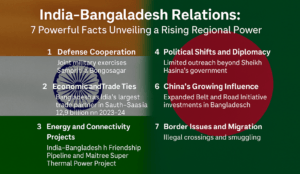India-Bangladesh Relations: 7 Powerful Facts Unveiling a Rising Regional Power Shift
India-Bangladesh relations have grown significantly across defence, trade, energy, and connectivity, making Bangladesh India’s closest partner in South Asia. The two nations conduct regular joint military exercises and patrols to ensure regional security. Trade ties are strong, with bilateral trade reaching $12.9 billion in 2023–24, driven by Indian exports like petroleum and engineering goods and Bangladeshi exports such as textiles and jute.
Connectivity projects like the India-Bangladesh Friendship Pipeline and Maitree Super Thermal Power Plant have deepened energy cooperation. However, challenges persist, including diplomatic friction after Sheikh Hasina’s exit, China’s growing influence through BRI investments, and issues like illegal migration and cross-border crime. Rising anti-India sentiment in Bangladesh also poses concerns. To strengthen ties, India must adopt a more inclusive diplomatic approach, enhance regional cooperation through forums like BIMSTEC, and promote cultural and educational exchanges.
A balanced, people-centric strategy will be key to ensuring a stable and mutually beneficial relationship.

India-Bangladesh Relations: 7 Powerful Facts Unveiling a Rising Regional Power Shift
During the recent BIMSTEC Summit in Bangkok, Indian Prime Minister Narendra Modi held discussions with Bangladesh’s Chief Adviser Muhammad Yunus. This marked their first official meeting since the removal of former Prime Minister Sheikh Hasina, signaling a shift in Bangladesh’s political landscape and its implications for bilateral ties.
Current State of Relations
- Defence Cooperation
India and Bangladesh share strong defence ties, highlighted by joint military exercises such as Sampriti (Army) and Bongosagar (Navy). These drills focus on enhancing combat readiness and interoperability. Both nations also conduct coordinated naval patrols to strengthen maritime security in the Bay of Bengal. - Economic and Trade Ties
Bangladesh is India’s largest trade partner in South Asia, with bilateral trade reaching $12.9 billion in 2023–24. India exports cotton, machinery, and petroleum products, while importing garments, textiles, and aerospace components from Bangladesh. This economic partnership supports employment and industry in both countries. - Energy and Infrastructure Projects
Key collaborations include the India-Bangladesh Friendship Pipeline, supplying 1 million metric tons of diesel annually to Bangladesh. Landmark connectivity projects like the Akhaura-Agartala Rail Link and the Maitri Setu Bridge have improved cross-border transport. The Maitree Super Thermal Power Plant, a joint venture, now supplies electricity to Bangladesh, addressing its growing energy needs. - Regional Partnerships
Both nations actively engage in regional forums such as SAARC, BIMSTEC, and the Indian Ocean Rim Association, working to promote economic integration and security across South Asia and the Indo-Pacific.
Challenges in the Relationship
- Political Shifts and Diplomacy
India’s historical alignment with Sheikh Hasina’s government has limited its outreach to other political factions in Bangladesh. With her removal, India now faces the challenge of rebuilding trust with the interim leadership. Past actions, such as hosting Hasina during her exile, have fueled perceptions of political interference. - China’s Growing Influence
China’s Belt and Road Initiative (BRI) has expanded its footprint in Bangladesh through major investments in ports, highways, and telecom projects. For instance, China’s involvement in the Teesta River restoration plan poses a strategic concern for India, which seeks to maintain its historical influence in the region. - Border Issues and Migration
Illegal crossings and smuggling along the 4,096-km border remain pressing concerns. The Rohingya refugee crisis has further strained resources in India’s northeastern states. Additionally, cross-border crimes, including drug trafficking and insurgent activities by groups such as ULFA, continue to challenge security forces. - Public Sentiment in Bangladesh
Anti-India narratives, driven by allegations of political interference, have gained ground. Protests with slogans like “Delhi vs. Dhaka” and social media campaigns such as #IndiaOut reflect growing skepticism, particularly among the youth in Bangladesh.
Strengthening the Partnership
- Expand Political Engagement
India should broaden its diplomatic outreach beyond formal government channels. Building ties with civil society, opposition leaders, and grassroots organizations through platforms like academic exchanges and track-2 diplomacy can foster broader trust. - Boost Regional Collaboration
Establishing a Bangladesh Engagement Forum with Indian border states like West Bengal, Assam, and Tripura could align local development goals with cross-border initiatives. Accelerating the BBIN Motor Vehicles Agreement would enhance regional trade and connectivity among Bangladesh, Bhutan, India, and Nepal. - Enhance Border Security
Speeding up the deployment of advanced border management systems, including smart fencing and the Comprehensive Integrated Border Management System (CIBMS), would help curb illegal activities while facilitating legitimate movement of people and goods. - Cultural and Educational Initiatives
Promoting cultural exchange through film festivals, art exhibitions, and scholarship programs like the Suborno Jayanti Scholarships can deepen people-to-people ties. Encouraging Bangladeshi students to pursue education in Indian institutions would foster long-term goodwill and mutual understanding. - Counterbalance China’s Role
India can position itself as a reliable development partner by offering competitive financing and technology for infrastructure projects. Collaborative efforts in areas like renewable energy and digital connectivity would align with Bangladesh’s development priorities while balancing China’s growing influence.
Conclusion
India and Bangladesh share deep-rooted cultural, economic, and strategic bonds. Addressing challenges such as China’s expanding role, migration pressures, and political perceptions requires thoughtful diplomacy and consistent engagement. By focusing on inclusive partnerships, enhanced connectivity, and cultural outreach, both countries can strengthen their roles as key drivers of stability and progress in South Asia.
You must be logged in to post a comment.